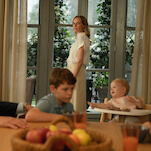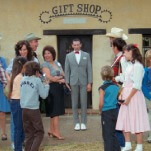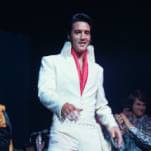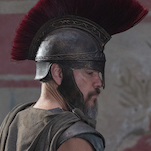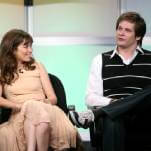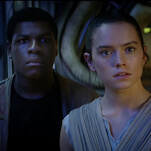It wasn’t real life.
Sure, Jay Z and Beyoncé’s On The Run tour physically delivered two of the most important people in pop music; they stood on a stage and performed their music to a crowd of thousands. But none of it was actually real: not their brilliantly edited short films, not their onstage dynamic, and certainly not the home videos set to “Halo” and “Forever Young” that tearfully closed out the show. Like the words that flashed when the concert began, “This isn’t real life.” And even when “this is real life” appeared atop just-grainy-enough footage of Blue Ivy, it was still painfully obvious that every move was just another brick in the Jay Z and Beyoncé dynasty. That every night, the two were doing a careful dance that showed us just enough of their true selves without giving anything valuable—or actually real—away.
Which is exactly what we paid for. We want to see characters—branded, highly calculated versions of these public selves, and not aspects like Instagram subtexts or Page Six gossip, which are none of our business. Fresh rumors of infidelity, impending divorce, or failed marriage counseling had (and have) no place within those two and a half hours. If we wanted to see mortals—if we wanted to see flaws—we’d look at each other, not the people onstage. And we certainly wouldn’t go to shows attended by thousands, where performers assume only the roles as the characters that made them famous. Authenticity has never had a huge place in popular music, and part of Jay Z and Beyoncé’s appeal lies in their mystery: As soon as you think you have them figured out, they release songs about menswear designers, or about sex in limousines, or about beauty norms in a patriarchal society. And with each new song, they shoot down their existing personas and emerge more exciting than before (especially Beyoncé).
Jay Z and Beyoncé’s self-appropriation is by no means new, especially in terms of stadium-level popularity. (Katy Perry probably doesn’t dress up like she lives in the Gumdrop Forest to go to the grocery store.) And obviously, every time musicians takes the stage, they’re giving their audience the artist they’re expected to be, and not the people they are. But, as their legacy dictates, Jay Z and Beyoncé do it better. From the second the opening video starts—footage of the duo brandishing guns and waxing poetic over “gangster shit”—they hook you. No longer are we seeing Jay Z and Beyoncé the people, we’re seeing Jay Z and Beyoncé the performers. And now we’re a part of their myth.
That myth begins with their first song, “’03 Bonnie And Clyde,” which goes hand-in-hand with their On The Run theme. They’re fugitives, and those wanting to get metaphorical might say that with this tour they’re trying to outrun everything from elevator fights to infidelity rumors. That track seamlessly transitions to Beyoncé’s “Upgrade U,” then “Crazy In Love,” before the official Jay-Bey trade-off starts. The two take turns wielding the mic, with entrances and exits made via everything from a floor elevator to a rotating chair.
And so what, right? Stadium shows call for theatrics and for some sort of theme. At this borderline-Vegas level, costume changes, big-screen graphics, and light tricks are old hat; considering One Direction has mastered the “mysterious” stage exit, Beyoncé and Jay Z aren’t exactly breaking ground here.
Which, technically—as in on a technological level—they aren’t. On The Run is a technically sound show, but is by no means the most controversial or complicated live production ever. The 3-D graphics and lights are cool, but no one left the concert saying, “Holy shit, I’ll never forget those lights!” It was about them. It’s always about them. Or, more specifically, her.
We know that Jay Z can hold his own live because he’s been making music for almost two decades, and it’s pretty clear that Beyoncé’s got more live talent than any of us will ever know. And that’s exactly the way each presented their own material: Jay Z appeared with the cool confidence of a man who’s built an empire out of nothing. Beyoncé’s presence can be summed up best by recalling her choice to sing “The Star Spangled Banner” at a press conference after her live performance was questioned at Obama’s second inauguration. An artist whose “bow down, bitches” is greeted with cheers (not with raised eyebrows), and who can brazenly sing, “Why Don’t You Love Me” in a partnership-themed concert. She’s Best Actress to her husband’s Best Supporting.
These were the roles they were meant to play. The clips shown throughout the show may have shown a man in charge, videotaping his wife atop piles of stolen money. They may have included a crying woman begging and pleading for her partner to come home. But then Jay Z and Beyoncé would appear live, and Beyoncé would, in a wedding dress, call out her husband’s (alleged) wandering eye in front of thousands of people. That is some gangster shit.
So far, complaints have sounded about the couple’s lack of banter, onstage chemistry, or even that the show was “too perfect”—but that’s exactly what makes On The Run even more movie- and myth-like. Any more of a glimpse into their personal lives could compromise their personas—not to mention that no artist owes the audience anything at all, aside from what they’ve paid for. (Which is music, performed live.) At the duo’s July 9 date in Toronto, I didn’t want elevator-fight footage; I wanted scenes from the On The Run trailer, starring every celebrity in the world. I didn’t want blind items from gossip sites, I wanted to watch Beyoncé sing and dance, then tell Jay Z his verse in “Drunk In Love” is terrible (even though she didn’t). I even wanted more Bonnie and Clyde, and less Blue Ivy—and not because I don’t think Blue Ivy is precious, but because she’s too young to take on a role in their production. (She can’t even sign a release yet.) I wanted to watch the movie.
Which I did. A movie doesn’t interrupt scenes for the leads to commiserate. A movie doesn’t encourage its actors to stand off mark. It doesn’t allow them to break the scene, or betray their roles. A movie is planned, calculated, scripted, and lit perfectly. It’s edited. It’s censored. It’s make-believe. It isn’t real life—it’s a movie. And On The Run was my favorite movie of 2014.


































